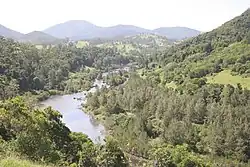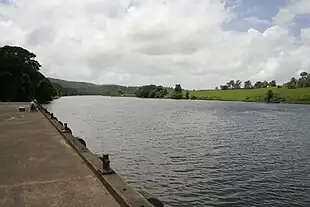| Manning River | |
|---|---|
 Manning River, upstream of Mount George | |
| Etymology | In honour of Sir William Manning[1] |
| Native name | Boolumbahtee (Birrpayi)[2] |
| Location | |
| Country | Australia |
| State | New South Wales |
| Region | New England Tablelands, NSW North Coast (IBRA), Northern Tablelands, Mid North Coast |
| Local government area | Mid-Coast Council |
| Towns | Wingham, Taree |
| Physical characteristics | |
| Source | Mount Barrington, Great Dividing Range |
| • location | Barrington Tops National Park, near Ellerston |
| • coordinates | 31°54′S 151°28′E / 31.900°S 151.467°E |
| • elevation | 1,500 m (4,900 ft) |
| Mouth | Tasman Sea of the South Pacific Ocean |
• location | Old Bar and Harrington Point |
• coordinates | 31°53′S 152°42′E / 31.883°S 152.700°E |
• elevation | 0 m (0 ft) |
| Length | 261 km (162 mi) |
| Basin size | 8,125 km2 (3,137 sq mi) |
| Discharge | |
| • location | Near mouth |
| • average | 63 m3/s (2,000 GL/a)[3] |
| Basin features | |
| Tributaries | |
| • left | Backwater Creek, Pigna Barney River, Barnard River, Nowendoc River, Connollys Creek, Bobin Creek, Dingo Creek, Cedar Party Creek, Dawson River, Lansdowne River |
| • right | Gloucester River, Bakers Creek (New South Wales), Burrell Creek (New South Wales), Scotts Creek (New South Wales) |
| National parks | Barrington Tops, Woko, |
| [4] | |
Manning River (Biripi: Boolumbahtee[2]), an open and trained mature wave dominated barrier estuary,[5] is located in the Northern Tablelands and Mid North Coast districts of New South Wales, Australia. It is the only double delta river in the southern hemisphere in which there are two permanent entrances to the river, one at Old Bar and another at Harrington, and is famously one of only two rivers in the world to have permanent multiple entrances with the other being the Nile river in Egypt.[6]
Course and features

Manning River rises below Mount Barrington, on the northeastern slopes of the Great Dividing Range within Barrington Tops National Park, east southeast of Ellerston, and flows generally southeast, joined by eleven tributaries including the Pigna Barney, Barnard, Nowendoc, Gloucester, Dawson, and Lansdowne rivers, descending 1,500 metres (4,900 ft) over its 261-kilometre (162 mi) course from the high upper reaches, through the Manning Valley, and out to sea.[4]
The river flows past the towns of Wingham and Taree. At Taree, the river splits and becomes a double delta. The southern arm reaches its mouth at the Tasman Sea of the South Pacific Ocean, near Old Bar. The northern arm is joined by the Dawson River and further downstream the Lansdowne River, reaching its mouth at the Tasman Sea, near Harrington Point; creating two separate entrances to the river: Harrington Inlet (north) and Farquhar Inlet (south). Within the delta there are several channels dividing coastal land into large islands, such as Mitchells and Oxley islands. Between Croki (in the north) and Cabbage Tree Island east of Bohnock (in the south), Scotts Creek links both the northern and southern passages of the river.
The Manning River is one of Australia's few large river systems that have not been dammed for water supply purposes anywhere along its catchment. The local water supply is fed by Bootawa Dam, which is an offsite dam, however, water is pumped from the river to the dam whenever river turbidity and flow levels can allow. A small weir is located in the upper reaches of the Barnard River, part of the inter-basin water transfer of the Barnard River Scheme, enabling water to be pumped into the Hunter River to meet the cooling needs of Bayswater and Liddell electric power stations.[7][8][9] The scheme is shut down until needed but as of 2006 this scheme was partly decommissioned due to its rare use.
The Manning River is one of only a few Australian mainland rivers to receive annual winter melting snow deposits.
The Manning River is variously traversed by the Pacific Highway between Taree and Coopernook, and the North Coast railway line at Taree.
History
The traditional custodians of the land surrounding the Manning River and its associated valley are the Australian Aboriginal Biripi,[10] who named the river as Boolumbahtee, meaning a place where the brolgas played.[2]
In 1818, John Oxley crossed and named Harrington and Farquhar inlets during a trip from the Hastings River, near Port Macquarie, to Port Stephens. The Manning River itself was first surveyed by Henry Dangar in 1825 and again in 1826 on behalf of the Australian Agricultural Company. Later in 1826, the river was named the Manning River by Robert Dawson for the Deputy Governor of the Australian Agricultural Company, William Manning.[11] In the same year it was declared that the Manning was the northern limit of the Nineteen Counties, defining the areas of New South Wales where settlers were free to occupy.
Until 1913, ships servicing the coast brought goods and supplies up the river. Wingham was established at the furthest point supply boats could reach up the river and became the region's major port. The old cargo wharf at Wingham Brush has since been refurbished. The town of Tinonee was also settled on the river near Taree.
In March 2021, a record breaking low pressure trough brought intense rainfall to the Manning Valley catchment area,[12] inundating properties at Taree and Wingham. It peaked at 5.7 m (19 ft) in Taree, falling just short of the record 6 m (20 ft) flood of 1929.[13]
Ecology
The Manning River is a large producer of Australian oysters and is home to many fish, the most common being the Dusky Flathead (Platycephalus fuscus), a common Australian estuary fish. It is also a habitat for the endangered Manning River helmeted turtle, which is endemic to the upper and middle catchments.[14][15] The Manning River is frequented by dolphins and sharks, with some venturing as far up the river to Wingham.
Whales also frequent the river, mainly at the larger Harrington Inlet, although some do enter the Farquar Inlet and generally do not venture far up river. However, on 16 September 1994 a rare tropical Bryde's whale measuring 9-metre (30 ft) long, nicknamed "Free Willy" by locals, ventured much further up river to Taree. After becoming a tourist attraction, and repeatedly evading attempts by conservationists to free him "Free Willy" was finally rescued by Seaworld Staff in conjunction with NSW National Parks And Wildlife and ORCA (Organisation for the Rescue and Research of Cetaceans in Australia). "Willy" became stranded on a sandbar, and with the assistance of a specially designed inflatable Cetacean Rescue Device, floated and towed back out to sea and was last seen heading for deeper water to the east.[16][17]
Events and industry
Taree is home to the annual Manning River Summer Festival, which features rowing, and sailing. The Taree Powerboat Club Spectacular is held in the Manning River during the Easter long weekend.
The Manning Point Fishing Classic, held annually at Manning Point is the Australian leg of the Poissons et boisson extrêmes extreme fishing tour. The tour pits an invitation only collection of notorious fishers, known for their extreme dedication to the twin arts of fishing and drinking.
Commercial fishing and oyster farming are both practiced in the Manning. The peak season for oyster production is September to March; and the annual production during 2013 was 146,000 dozen.[18] The link between Taree and the oyster industry is shown by the presence in Taree of the "Big Oyster", a building constructed in the shape of an open oyster shell.
The Manning River area is popular for domestic tourism.
See also
References
- ↑ Reed A. W. (1984). Place Names of Australia (3rd reprint ed.). Reed Books. p. 146. ISBN 0-589-50128-3.
- 1 2 3 Collier, Gloria; O'Hara, Joan (February 1998). "Oxley Island". The Journal. Manning Valley Historical Society (3). Archived from the original on 4 March 2016. Retrieved 16 March 2013.
- ↑ "East Coastal Watersheds".
- 1 2 "Map of Manning River, NSW". Bonzle Digital Atlas of Australia. Retrieved 16 March 2013.
- ↑ Roy, P. S.; Williams, R. J.; Jones, A. R.; Yassini, I.; et al. (2001). "Structure and Function of South-east Australian Estuaries". Estuarine, Coastal and Shelf Science. 53 (3): 351–384. doi:10.1006/ecss.2001.0796.
- ↑ Driscoll, Julia (12 December 2019). "The river runs dry: Manning River at zero flow". The Canberra Times. Retrieved 1 October 2021.
- ↑ "Macquarie Generation Hunter River Pump Station Augmentation Environmental Assessment" (PDF). Connell Wagner Pty Ltd. Macquarie Generation. 16 January 2007. p. 29. Retrieved 16 March 2013.
- ↑ "Macquarie Generation". Office of Water. Department of Primary Industries. 12 December 2011. Retrieved 16 March 2013.
- ↑ "Hunter River NSW". Hunter River Explorer. Archived from the original on 9 April 2013. Retrieved 16 March 2013.
- ↑ Klaver, J; Kefferman, K J. "Aboriginal Culture and history in the Manning Valley" (PDF). Greater Taree Aboriginal Heritage Study. Manning Valley Tourism. p. 1. Retrieved 16 March 2013.
- ↑ The Present State of Australia by Robert Dawson, page 372.
- ↑ "Martin Bridge at Taree closed to all traffic, including emergency services". Manning River Times. Australian Community Media. 21 March 2021. Retrieved 22 March 2021.
- ↑ http://www.bom.gov.au/climate/current/statements/scs74.pdf
- ↑ "MANNING RIVER TURTLE". Aussie Ark. 20 July 2021. Retrieved 1 October 2021.
- ↑ "Manning River Helmeted Turtle, Purvis' Turtle - profile | NSW Environment, Energy and Science". environment.nsw.gov.au. Retrieved 1 October 2021.
- ↑ "Australians trying to free whale Willy". Eugene Register-Guard. Associated Press. 17 November 2004. Retrieved 19 May 2010.
- ↑ Bryde's whale breaches off Tacking Point coastline
- ↑ Parker, Sarah (5 June 2013). "Plan for future health of Manning oyster industry". Manning River Times. Retrieved 13 October 2013.
External links
- "Manning River catchments" (map). Office of Environment and Heritage. Government of New South Wales.
- "The Lower North Coast". Hunter-Central Rivers Catchment Management Authority. Government of New South Wales. 2012. Retrieved 16 March 2013.